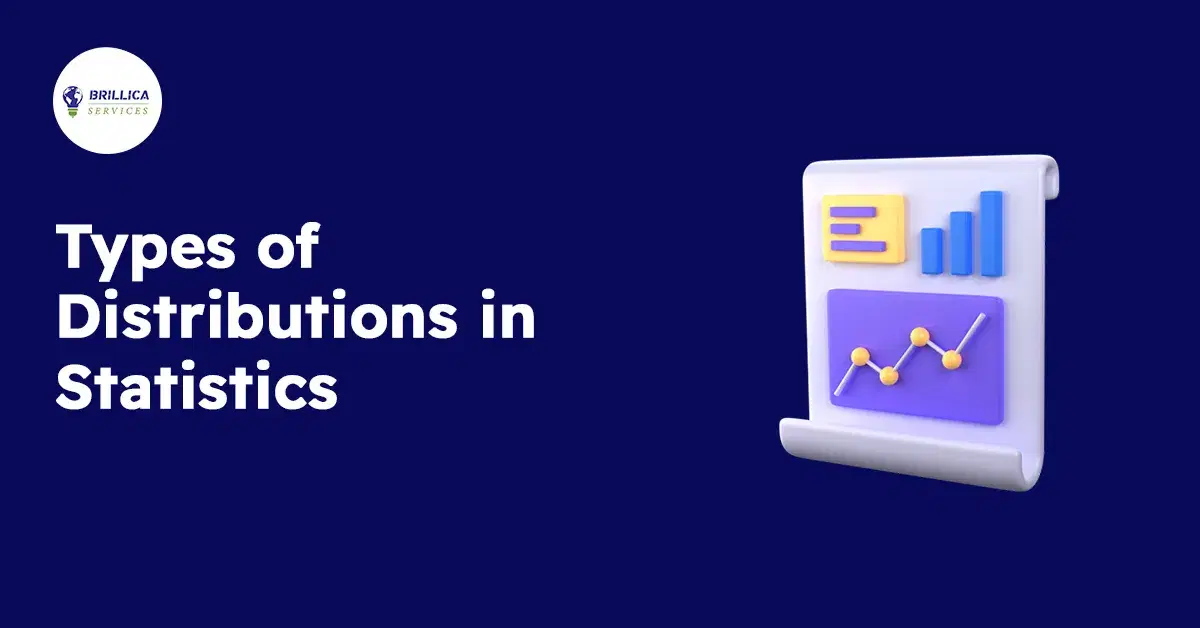What is a Distribution in Statistics?
In statistics, a distribution refers to how data points are spread across a range of values. It is a fundamental concept that describes the pattern, frequency, or likelihood of different outcomes in a dataset.
Essentially, a distribution helps us visualise and understand the behaviour of data, showing whether values are clustered, evenly spread, or skewed in a particular direction.
A distribution is typically represented using graphs, charts, or mathematical functions such as histograms, probability density functions, or cumulative distribution functions. For example, if you measure the heights of a group of people, the resulting data will likely form a bell-shaped curve known as a normal distribution.
Some key terms to understand distributions include:
- Mean (Average): The central value of a dataset.
- Median: The central value of a dataset when its elements are sorted in ascending or descending order.
- Mode: The most frequently occurring value.
- Range: The span between the largest and smallest values in a dataset.
In simple terms, a distribution is a tool that helps statisticians and analysts summarise data and extract meaningful insights.
Importance of Understanding Distributions in Data Analysis
Gaining a clear understanding of distributions is essential for effective data analysis for several key reasons.
Identifying Patterns in Data
Distributions reveal patterns such as symmetry, skewness, and kurtosis, helping analysts understand the underlying behaviour of data. For instance, a normal distribution suggests a balanced dataset, while a skewed distribution indicates an asymmetry that needs further investigation.
Improving Decision-Making
Accurate knowledge of data distributions allows for better predictions and decision-making. For example, businesses can use demand distribution data to optimise inventory management.
Selecting Appropriate Statistical Tests
Many statistical tests rely on specific assumptions about data distribution. For instance, parametric tests like the t-test assume a normal distribution, while non-parametric tests are suitable for skewed or non-normal data.
Enhancing Data Visualisation
Distributions provide a foundation for creating visual representations like histograms or box plots, enabling clearer communication of data insights.
Real-Life Applications
- Finance: Understanding stock price distributions helps in risk assessment.
- Healthcare: Analysing patient recovery time distributions aids in resource allocation.
- Education: Exam score distributions help evaluate the effectiveness of teaching methods.
Without a proper grasp of distributions, data analysis risks misinterpretation, leading to flawed conclusions and decisions.
Brief Overview of Types of Distributions in Statistics
Distributions in statistics are broadly classified into two categories:
Discrete Distributions
These relate to data points that can only have particular, discrete values. For example:
- Binomial Distribution: Used to model binary outcomes like success/failure.
- Poisson Distribution: Represents the occurrence of rare events, such as the number of accidents at a junction in a day.

Continuous Distributions
These pertain to data points that can assume any value within a specified range. Examples include:
- Normal Distribution: Also known as the bell curve, it is symmetric and widely used in natural and social sciences.
- Exponential Distribution: Often used to model time between events, such as the time until a machine fails.
Other types of distributions include:
- Uniform Distribution: All outcomes are equally likely.
- Chi-Square, T-Distribution, and F-Distribution: Commonly used in hypothesis testing and regression analysis.
By understanding these types, statisticians can choose the most appropriate model to represent their data, ensuring accurate analyses and predictions.
Why Are Distributions Important in Statistics?
Distributions play a foundational role in statistics, serving as a framework for organising, analysing, and interpreting data.
They provide insights into how data is spread, the frequency of specific values, and the likelihood of outcomes. Whether you’re a data scientist, a researcher, or a business analyst, understanding distributions is crucial for making sense of data and applying the correct statistical methods.
Role of Distributions in Statistical Analysis
1. Summarising Data
Distributions help summarise large datasets by providing a clear structure. For instance, measures like the mean, median, and mode are derived from distributions and help describe central tendencies. The shape of a distribution—whether normal, skewed, or uniform—also reveals significant characteristics of the dataset.
2. Determining Probabilities
Probability distributions are essential in statistics for estimating the likelihood of specific outcomes. For example:
- In a binomial distribution, you can calculate the probability of a certain number of successes in a series of trials.
- In a normal distribution, probabilities can be determined using the area under the curve for a specific range of values.
- This capability makes distributions invaluable in risk assessment, forecasting, and decision-making processes.
3. Choosing Appropriate Statistical Methods
Many statistical tests and models are designed for specific types of distributions. For instance:
- Parametric tests like t-tests and ANOVA assume the data follows a normal distribution.
- Non-parametric tests like the Mann-Whitney U test are suitable for data that doesn’t follow a normal distribution.
- Understanding the distribution of data ensures the right tools are applied, leading to more accurate results.
4. Interpreting Variability and Patterns
Distributions reveal variability in data, showing whether values are tightly clustered or widely spread. Skewness (asymmetry) and kurtosis (peakedness) further describe patterns that could impact analysis. For example, in financial data, understanding skewness can highlight risks of extreme losses or gains.
5. Facilitating Data Visualisation
Graphs like histograms, box plots, and density plots are built on the concept of distributions. These visual tools make it easier to identify patterns, outliers, and trends at a glance, enhancing data communication and understanding.
Applications of Distributions in Real-World Scenarios
Distributions are not just theoretical concepts—they are applied in countless real-world situations across industries:
1. Business and Finance
- Risk Assessment: Financial analysts use normal and skewed distributions to evaluate investment risks and returns.
- Market Research: Distributions help in understanding customer behaviour, like purchase frequency or response to discounts.
2. Healthcare
- Patient Data Analysis: Normal distribution is often used to analyse variables like blood pressure or cholesterol levels.
- Epidemiology: Poisson distribution helps model the occurrence of rare diseases or outbreaks.
3. Engineering and Manufacturing
- Quality Control: Uniform and normal distributions help monitor product consistency and defects.
- Failure Analysis: Exponential distribution models the time between failures in mechanical systems.
4. Education and Psychology
- Exam Scores: Exam results often follow a normal distribution, aiding in grading systems and performance evaluations.
- Behavioural Studies: Distributions help model response patterns in psychological experiments.
5. Environmental Science
- Weather Predictions: Meteorologists use distributions to model rainfall, temperature, and wind speeds.
- Resource Allocation: Understanding resource consumption distributions aids in planning and sustainability.
6. Technology and AI
- Machine Learning Models: Many algorithms, like Gaussian Naive Bayes, rely on assumptions about data distributions.
- Data Anomalies: Identifying outliers in distributions helps in detecting fraud or errors in systems.
Why Mastering Distributions Matters
By understanding distributions, statisticians and analysts can uncover hidden patterns, predict outcomes, and make informed decisions.
The applications are endless, ranging from optimising business operations to advancing scientific research.
Mastering the role of distributions in statistics ensures that data-driven conclusions are accurate, reliable, and actionable.
For students, professionals, or anyone seeking to explore statistics, developing a strong foundation in distributions is a critical step toward becoming proficient in data analysis.
Types of Distributions in Statistics
Statistical distributions are the backbone of data analysis, enabling us to understand how data points are spread, determine probabilities, and apply statistical methods.
Each type of distribution serves specific purposes, making it essential to understand their characteristics, formulas, and real-world applications.
Let’s delve into the details of the most significant types of distributions.
1. Normal Distribution
Characteristics of a Normal Distribution
The normal distribution, commonly referred to as the bell curve, is among the most recognised and extensively utilised statistical distributions.
Key characteristics include:
- Symmetry: The curve is entirely symmetrical about the mean.
- Central Tendency: The mean, median, and mode coincide at the peak of the curve.
- Standard Deviation: Approximately 68% of the data falls within one standard deviation from the mean, 95% within two, and 99.7% within three.
- Infinite Tails: The curve stretches endlessly in both directions but never intersects the horizontal axis.
Examples of Normal Distribution in Real Life
- Human Height: The distribution of adult heights within a population often follows a bell-shaped curve.
- Exam Scores: Standardised test scores, such as IQ tests or SAT scores, often follow a normal distribution.
- Market Returns: Stock market returns are frequently assumed to be normally distributed in financial modeling.
Importance in Hypothesis Testing
The normal distribution is essential in hypothesis testing and inferential statistics because:
- Many real-world phenomena naturally follow a normal distribution.
- It simplifies computations for probabilities and z-scores.
- Parametric tests like t-tests and ANOVA rely on the assumption that data follows a normal distribution, making it critical in scientific research and analytics.
2. Binomial Distribution
Explanation and Formula
The binomial distribution models the count of successes across a set number of independent trials, with each trial having only two possible outcomes: success or failure. The probability of observing exactly k successes in n trials is calculated as:

Where:
n = total number of trials.
k = number of successes.
p = probability of success in each trial.
When to Use Binomial Distribution
The binomial distribution is applicable when:
- The process involves a fixed number of trials.
- Each trial is independent of the others.
- Each trial results in only two distinct outcomes (binary outcomes).
Examples and Applications
- Quality Control: Assessing the likelihood of defective items within a production batch.
- Sports Analytics: Predicting the number of goals scored in a series of matches.
- Customer Behaviour: Estimating the likelihood of a customer purchasing a product in a marketing campaign.
3. Poisson Distribution
Understanding the Poisson Distribution
The Poisson distribution is used to model the number of times an event occurs within a fixed interval of time or space, assuming the events are independent and occur at a constant average rate. Its formula is:

Where:
λ = average number of occurrences in the interval.
k = actual number of occurrences.
e = Euler's number (~2.718).
Real-Life Applications of Poisson Distribution
- Call Centres: Predicting the hourly volume of incoming calls.
- Public Transportation: Predicting the arrival of buses or trains at a station.
- Healthcare: Modelling the frequency of patient arrivals in an emergency room.
4. Exponential Distribution
Characteristics and Formula
The exponential distribution models the time intervals between successive events in a Poisson process. Its probability density function (PDF) is:

Where
λ is the rate parameter, indicating how frequently events occur.
Examples and Usage in Predicting Events Over Time
- Machine Maintenance: Estimating the time until a machine part experiences failure.
- Customer Service: Estimating waiting times for service at a bank or restaurant.
- Natural Events: Modeling the time between earthquakes in a specific region.
5. Uniform Distribution
Key Features of Uniform Distribution
The uniform distribution characterises scenarios where every outcome has an equal probability of occurring. It is defined by a uniform probability density function that remains constant.
- Discrete Uniform Distribution: For example, rolling a die results in an equal chance for each number from 1 to 6.
- Continuous Uniform Distribution: Generating random numbers between 0 and 1, where all values are equally probable.
Application Scenarios
- Resource Allocation: Distributing tasks evenly across multiple workers.
- Random Sampling: Selecting individuals or objects randomly for a study or survey.
- Gaming: Designing games of chance where outcomes are fair and random.
6. Other Important Distributions
While the distributions above cover many standard use cases, several additional distributions are crucial for specific statistical analyses:
Chi-Square Distribution
- Purpose: Primarily used in tests of independence and goodness-of-fit analyses.
- Applications: Analyzing categorical data, like survey responses or frequency distributions.
T-Distribution
- Purpose: Used when the sample size is small, and the population standard deviation is unknown.
- Applications: Hypothesis testing for means, especially in small sample research studies.
F-Distribution
- Purpose: Applied to compare the variability between two or more groups.
- Applications: Crucial for conducting analysis of variance (ANOVA) and performing regression analysis.





